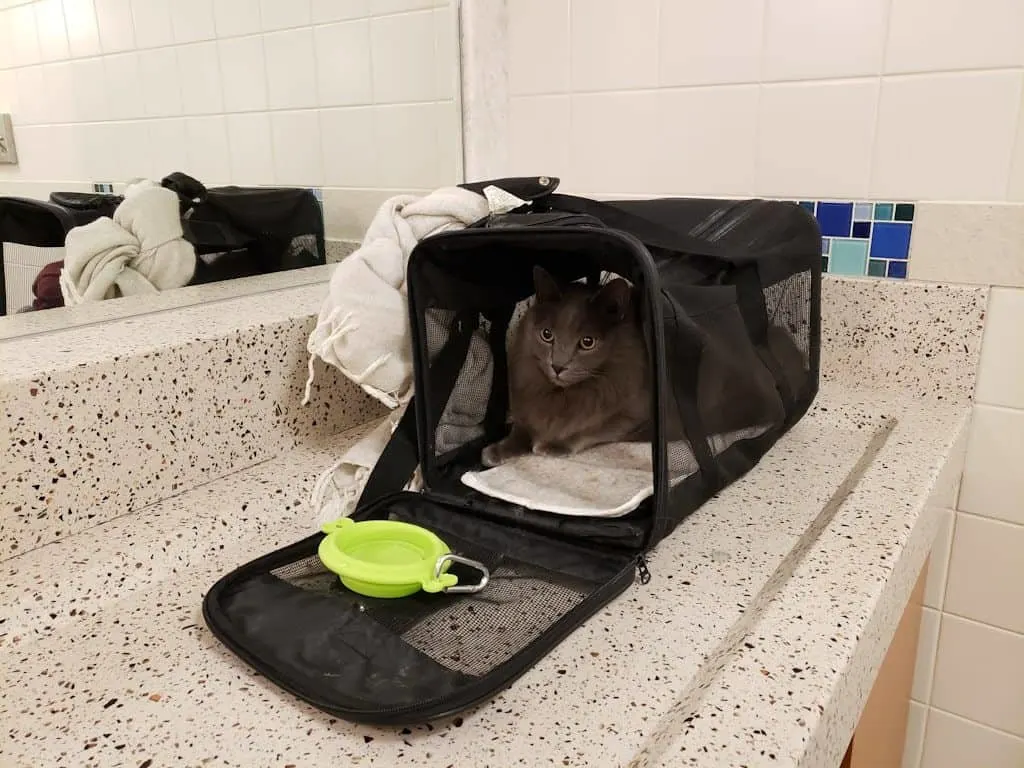Planning on flying to Mexico with your cat and escape the cold in Canada or the US? We just flew to Mexico with our cat Yoda for the second time! Read more below to find out the latest updates on requirements for cats and dogs traveling to Mexico.
The first time we entered the country with our cat, we had to provide health documentation — specifically, the international health certificate signed by both a vet and a USDA APHIS officer. But as of December 16th, 2019, pet parents traveling with a cat or dog no longer need health documentation to enter Mexico from the United States.
This December 2019 update will change the way people travel to Mexico with their pets! I am personally grateful for the change, as the previous process was time-consuming and expensive.
In this guide on traveling to Mexico with a cat, we’ll lay out what you need, and what to keep in mind when planning your trip!
Pets Traveling to Mexico via the USA
Thanks to the recent update, now when flying to Mexico with a cat or dog, all you need to do is stop by the Servicio Nacional de Sanidad, Inocuidad y Calidad Agroalimentaria (SENASICA) office located inside the airport as you make your way through immigration. There, An officer will conduct a brief physical inspection of your pet.
You no longer need to obtain the 10-day international health certificate at your local vet in order to fly to Mexico.
However, please note that some airlines still might require health certificates for pet travel.
Some airlines, such as American Airlines, do not require an international health certificate to fly from Canada-US, US-Canada, or Canada-Mexico (those are the routes we recently traveled with Yoda).
Also Read: The 12 Best Airlines for Cats [Ultimate Guide 2020]
Information you still need to give
You will still likely need to give the SAGARAPA/SENASICA personnel the following:
- Name
- Destination (hotel/apartment) address in Mexico
- Phone number
- Proof of rabies vaccine + vaccinations for your cat including internal/external deworming
I personally wouldn’t feel comfortable if I didn’t show up with some proof of Yoda’s vaccinations, so take those with you. Even though they don’t require a health certificate, they might want to see your pet’s health history. But that’s just me being extra careful!
Don’t forget to ensure a clean carrier, free of any toys, collars, or blankets. Only an absorbent pad should line the bottom of your pet’s carrier for in-cabin travel.

Yoda in the airport bathroom getting a break. | The Fluffy Kitty
Flying to Mexico with a Cat via Canada
If you are traveling from Canada to Mexico, as many ex-pats do in order to escape the cold winter months, then you still DO need a health certificate from a vet stating your pet is fit to fly.
Now, we had an awful experience with exactly this. Our vet in Canada didn’t know – or have – the required documents. At first, she said we needed a signature from a CFIA (Canadian Food Inspection Agency). But seeing as we were leaving the very next day, that was impossible. After making a few lengthy phone calls, she found out that, in fact, we did not need a CFIA signature. Just hers.
Side story: She nearly didn’t sign off because Yoda was upset (she tried to blindfold him) and she couldn’t conduct a physical exam. I helped hold him, as I had suggested in the first place, and she was able to make out his heartbeat and take his temperature. She then signed off that we could fly to Mexico. All in all, it was a horrendous experience. Please, do your research and don’t wait last minute for your vet appointment.
Call the SENASICA Office inside the airport in Mexico you’re flying to if you must in order to ask about what exactly you need. For us, it was just a regular health certificate only signed by our local vet.
BOTTOM LINE: We entered Mexico from Canada with only a hand-printed document, stamped and signed by our vet, issuing that Yoda was in good health to fly. It is unclear whether the updated December 2019 policy affects pets traveling from Canada, or if that is just the new regulation for those leaving the U.S.
General Pet Health Tips for Travel
To be on the safe side, even though you might not need health documentation if traveling with a pet from the US, please note that it is a safe practice for your cat or dog to be:
- Microchipped
- De-wormed
- Treated for ticks/parasites/fleas
- Visibly healthy
When arriving in Mexico with your cat, you should keep at least some documentation with you of your pet’s past vaccinations (in case this information is requested). Make copies and tuck them away in your bag for safekeeping.
⚠️ Please never sedate your pet for travel on airplanes. Sedation can be more harmful than helpful, and many vets do not recommend it.

Scenes from Puerto Vallarta, Mexico | PC: Canva
Popular Mexico Airports for Cats/Dogs
There are a few major Mexico airports where most foreign cats or dogs arrive. The two times that we’ve moved to Mexico, we have arrived at the Puerto Vallarta airport. On our most recent trip back to Mexico, the plane was booked full of domestic dogs and cats.
Puerto Vallarta: The pet immigration office is just past immigration on your left (across from the baggage claim). Even with 4 dogs in front of us, the line went fairly quickly. The officers did not even ask me to get Yoda out to inspect him. Most dogs were already on-leash, and the officer simply looked them over (eyes, ears, teeth, etc.)
Mexico City: I have no personal experience arriving in Mexico City with my cat. But, from research, it looks like the pet immigration offices are in both Terminal 1 and Terminal 2. The corresponding email is: [email protected]
Cancun: Neither do I have personal experience flying into Cancun with our cat. But, I assume it is similar to Puerto Vallarta. You’ll need to declare on your immigration form that you’re traveling with a live animal before preceding to pass through the pet immigration office inside the international airport.
Cat Safety Tips for Flying to Mexico
Luckily, most flights from the U.S. or Canada to Mexico are relatively short — within the 4-5 hour range from popular destinations.
With that said, you shouldn’t need to bring a litter box with you, but if your cat has a sensitive or nervous bladder, it’s wise to bring a travel litter box.
I also clip on a collapsible silicone food/water bowl for Yoda. Throughout the flight, I give my cat a shallow bowl of water.
For flights over 4 hours, I try to take Yoda to the bathroom and pick him up out of his carrier. I use this opportunity to get him out, let him stretch his legs, and massage him so he doesn’t get sore just sleeping in a carrier under my airplane seat.
Have you ever flown to Mexico with your cat or dog? Have you experienced it before or after the new US-Mexico health certificate update?
Drop your thoughts and comments with us below! For any questions related to traveling or flying with your cat to Mexico, you can contact us here.



Monika
Thursday 20th of October 2022
Will the same sort of paperwork be needed traveling back from Mexico to the US?
The Fluffy Kitty
Sunday 6th of November 2022
Hey Monika! No, importation into the US is actually easy. You don't even need proof of rabies, or a vet certificate. But the airline might need those things, so double check who you're flying with. According to the U.S. Customs and Border Protection website, "As a general rule, there are no restrictions on bringing domestic cats into the United States. A general certificate of health is not required by the Centers for Disease Control and Prevention (CDC)."
daya
Friday 11th of February 2022
Hello!
How about going back to canada? are there any additional papers needed?
Best, Daya
The Fluffy Kitty
Sunday 20th of February 2022
For Canada, you need to have the usual: health certificate (signed by your vet), proof of up to date vaccinations, and rabies certificate!
Tricia
Wednesday 8th of December 2021
Does the rabies vaccination certificate have to be issued by a US vet? I am transiting my cat from Australia to the US next week. I am a US citizen, but have had my cat here in Australia with me for years. I will be spending about a week in the US, so will I have any issues with an Australian vet issued rabies certificate?
The Fluffy Kitty
Saturday 11th of December 2021
Hi Tricia! The US doesn't require rabies vaccination for the import of cats. However, some specific states might require it. Also, the rabies certificate just needs to be issued by any accredited vet, so certainly vets in Australia will have what you need. Although the US doesn't need rabies certification, you will most likely need the international health certificate stating your cat is fit to fly. Your vet in Australia can do that. Check requirements from Australia > USA specifically on CDC website here. Lmk if you have more questions! x
vickypetsky
Tuesday 11th of August 2020
I want to travel with my cat. This article is a good guide.
Tel-Aviv's feral cats
Tuesday 10th of March 2020
I was wondering; when a person relocates to another country with a cat, does the cat have to go into isolation?
And what does isolation mean, that the cat should stay indoors in the new house with its owner, or taken from the owner and put in a cage someplace?
I'm a bit confused about this because I've talked to some people who'd taken cats and dogs abroad, and they said there was no isolation, but then I read somewhere on the web about a cat that did have to be isolated for 30 days without its owner.
I'm not thinking about going anywhere at this point, but just in case I do go somewhere in the future. That won't be anytime in the near future, not for a long time, but still, it would be nice to know.
The Fluffy Kitty
Tuesday 7th of April 2020
No, they don't always have to go into quarantine! It all depends on the country's requirements. For example Australia or New Zealand do require quarantine periods. But Mexico, for example, or the US, do not! We have other guides for flying with cats and the documents you need for international travel. I'm sure most of your questions are answered in those! Feel free to take a look!